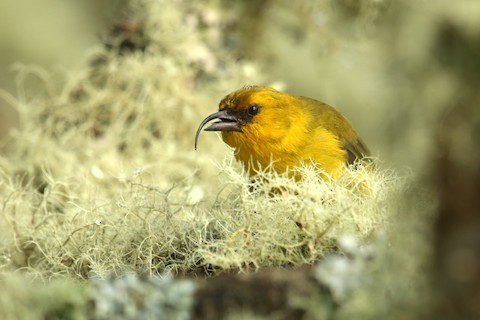Birdfinding.info ⇒ Endangered and naturally uncommon, the Akiapola’au (ah-kee-ah-PO-LAH-OW), or Aki, is certainly the most peculiar of Hawaii’s surviving honeycreepers. Although it has vanished from most of its original range, conservation efforts appear to have succeeded in its remaining strongholds. It can be found on tours of the restricted Pua Akala Tract in Hakalau Forest National Wildlife Refuge, and fairly consistently on the publicly accessible Pu’u O’o Trail along Saddle Road.
Akiapola’au
Hemignathus wilsoni
Endemic to the Big Island of Hawaii, where it occurs in native forests, mainly on the eastern side of the island between about 1,500 and 2,700 m elevation.
It thrives in forests dominated by koa trees, where it feeds on beetle larvae that it extracts by probing and peeling bark. Also known to produce sap wells by drilling into tree trunks.
Formerly occurred throughout most of the island; current distribution consists of fragmentary remnants, which have decreased in number and size.
Resident populations inhabit four separate areas: (1) Hakalau Forest National Wildlife Refuge on the eastern slopes of Mauna Kea; (2) the kipukas of the Hilo and Upper Waiakea Forest Reserves southeast of Mauna Kea; (3) the Keauhou-Kulani area, north of Hawaii Volcanoes National Park; and (4) Ka’u and Kapapala Forest Reserves on the southeastern slopes of Mauna Loa.
In the 1990s and early 2000s, two small subpopulations disappeared: one on the upper western slopes of Mauna Kea, and the other in the southern Kona highlands (western slopes of Mauna Loa).
Unlike most of Hawaii’s native birds, the Akiapola’au shows signs of rebounding. In the late 1970s, its total population was estimated at around 1,500, but by 2005 it was close to 2,100, with significant numbers in each of the four areas identified above.
Identification
A plump, short-tailed honeycreeper with an extraordinary bill that seems to combine two entirely unrelated tools: a stout, straight, sharp-tipped spike-like lower mandible and a long, thin, delicate, strongly decurved upper mandible.
In addition to its bizarre bill, it often appears to have a peculiarly steep forehead.
The male is bright-yellow overall, shading to orange on the head and olive on the back, wings, and tail, with a blackish mask.
Females and immatures are grayish-olive, sometimes with yellower patched on the underparts.
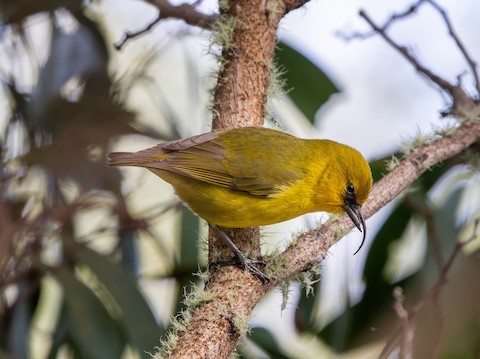
Akiapola’au, male. (Hakalau Forest National Wildlife Refuge, Big Island, Hawaii; January 7, 2020.) © William Higgins
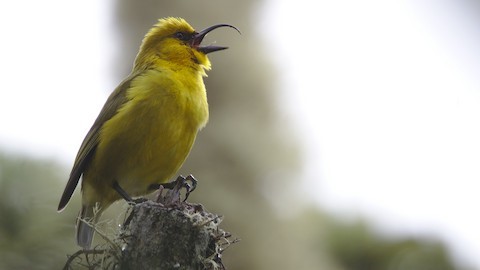
Akiapola’au, male. (Hakalau Forest National Wildlife Refuge, Big Island, Hawaii; July 10, 2018.) © Mark Scheel
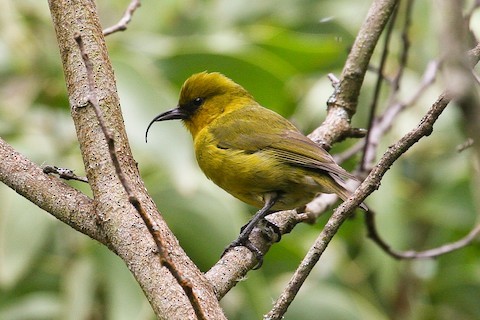
Akiapola’au, male. (Pu’u O’o Trail, Kipuka Ainahou, Big Island, Hawaii; September 22, 2006.) © Eric VanderWerf
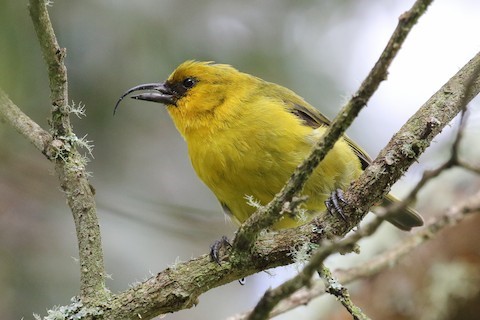
Akiapola’au, male. (Hakalau Forest National Wildlife Refuge, Big Island, Hawaii; April 9, 2019.) © Chris Benesh
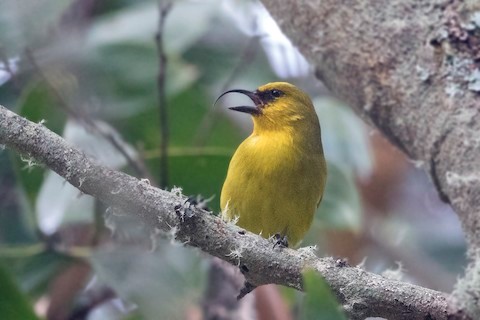
Akiapola’au, male. (Pua Akala Tract, Hakalau Forest National Wildlife Refuge, Big Island, Hawaii; September 17, 2018.) © Bradley Hacker
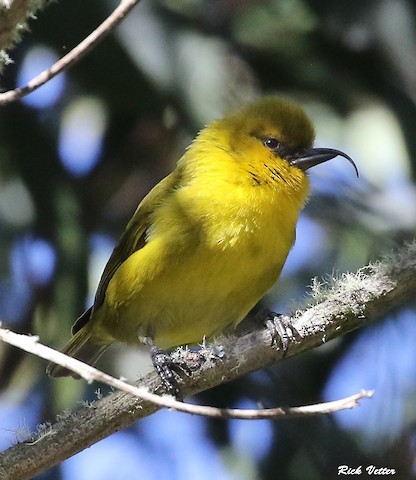
Akiapola’au, male, accentuating its peculiarly steep forehead. (Pua Akala Tract, Hakalau Forest National Wildlife Refuge, Big Island, Hawaii; December 6, 2018.) © Rick Vetter
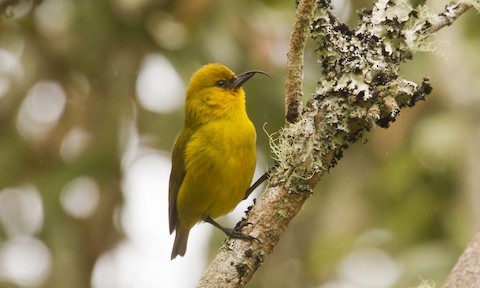
Akiapola’au, male. (Pu’u O’o Trail, Kipuka Ainahou, Big Island, Hawaii; March 2, 2013.) © Eric VanderWerf
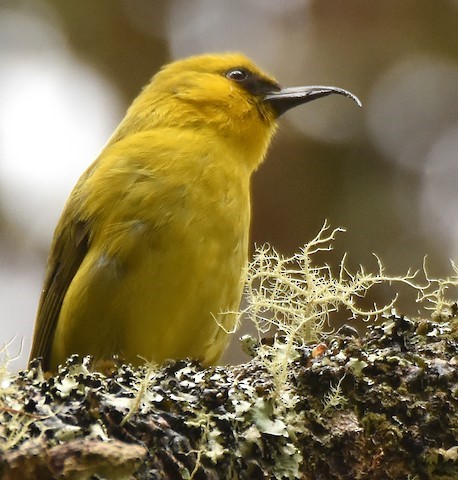
Akiapola’au, male. (Pu’u O’o Trail, Kipuka Ainahou, Big Island, Hawaii; August 2, 2015.) © Steven Mlodinow
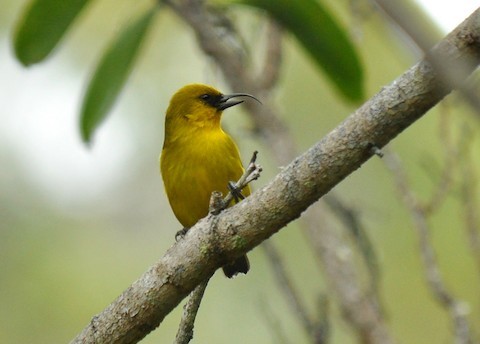
Akiapola’au, male. (Pu’u O’o Trail, Kipuka Ainahou, Big Island, Hawaii; November 4, 2011.) © Ryan O’Donnell
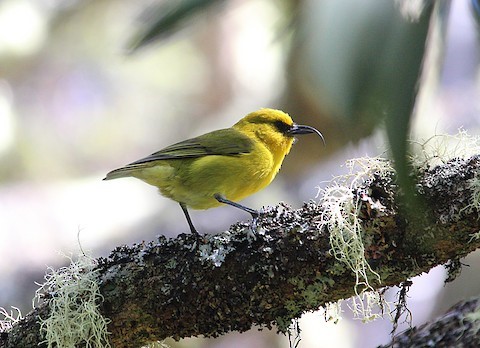
Akiapola’au, male. (Pua Akala Tract, Hakalau Forest National Wildlife Refuge, Big Island, Hawaii; September 23, 2018.) © Kathryn Hart
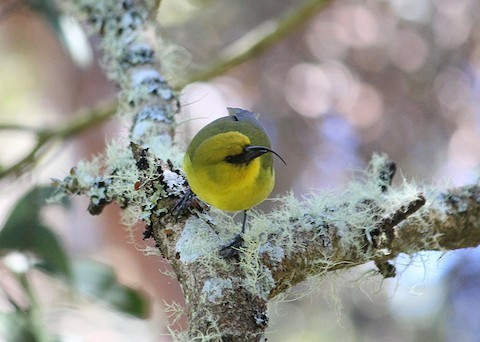
Akiapola’au, male. (Pua Akala Tract, Hakalau Forest National Wildlife Refuge, Big Island, Hawaii; September 23, 2018.) © Kathryn Hart
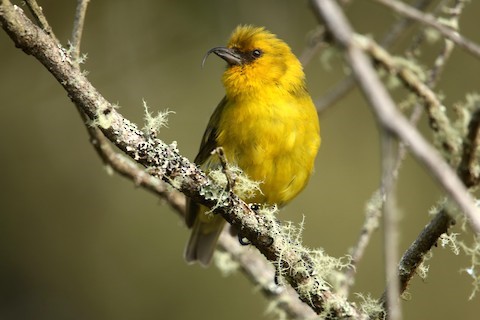
Akiapola’au, male. (Hakalau Forest National Wildlife Refuge, Big Island, Hawaii; April 9, 2019.) © Aaron Maizlish
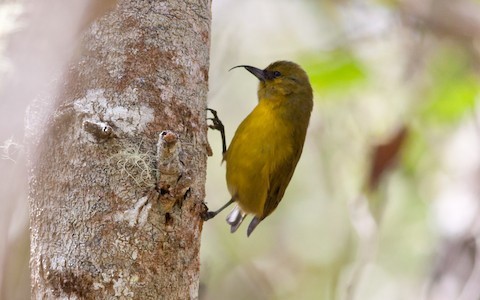
Akiapola’au, male showing its vertical facial profile. (Pu’u O’o Trail, Kipuka Ainahou, Big Island, Hawaii; July 17, 2013.) © Michael Todd
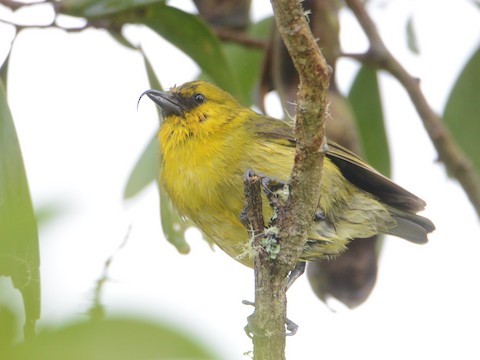
Akiapola’au, male showing its peculiarly short tail. (Pua Akala Tract, Hakalau Forest National Wildlife Refuge, Big Island, Hawaii; November 28, 2015.) © Alan Van Norman
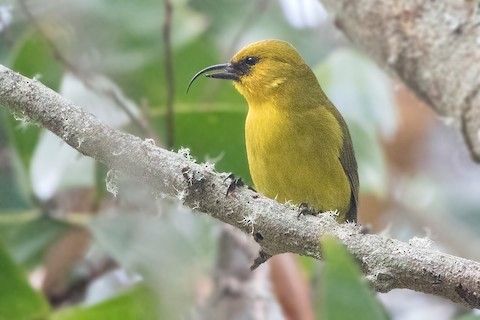
Akiapola’au, male. (Pua Akala Tract, Hakalau Forest National Wildlife Refuge, Big Island, Hawaii; September 17, 2018.) © Bradley Hacker
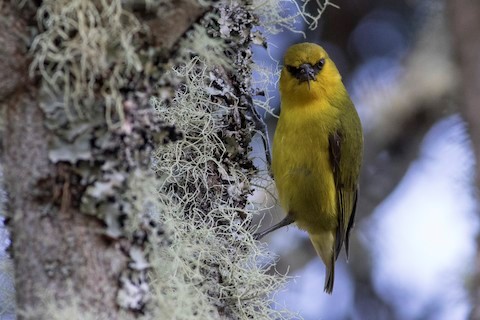
Akiapola’au, male. (Hakalau Forest National Wildlife Refuge, Big Island, Hawaii; March 19, 2019.) © Jacob Drucker
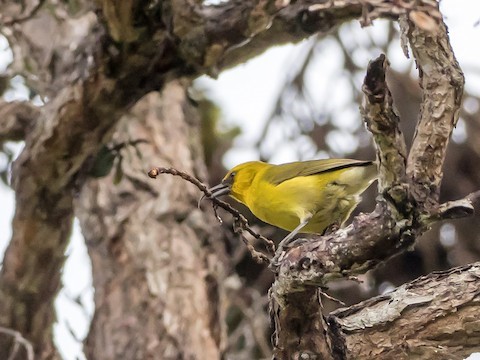
Akiapola’au, male, carrying a twig. (Pua Akala Tract, Hakalau Forest National Wildlife Refuge, Big Island, Hawaii; January 21, 2018.) © Ray Duffy
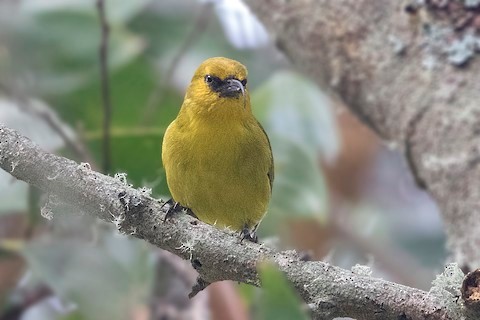
Akiapola’au, male. (Pua Akala Tract, Hakalau Forest National Wildlife Refuge, Big Island, Hawaii; September 17, 2018.) © Bradley Hacker
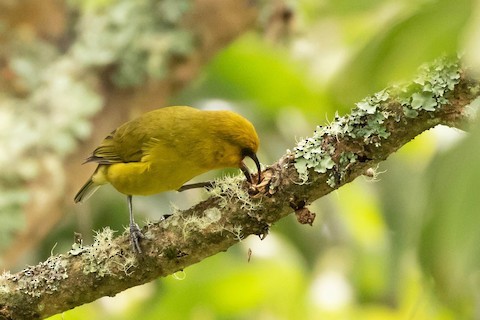
Akiapola’au, male, using its differing mandibles to probe and peel bark. (Pua Akala Tract, Hakalau Forest National Wildlife Refuge, Big Island, Hawaii; June 4, 2018.) © Fred Hochstaedter
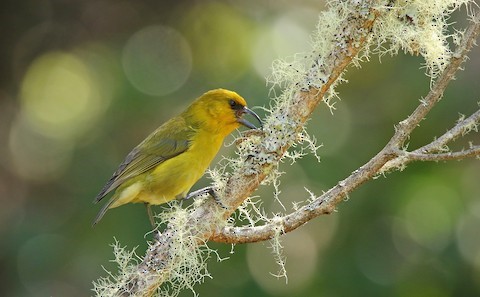
Akiapola’au, male, using its differing mandibles to probe and peel bark. (Pua Akala Tract, Hakalau Forest National Wildlife Refuge, Big Island, Hawaii; August 5, 2017.) © Thanasis Tsafonis
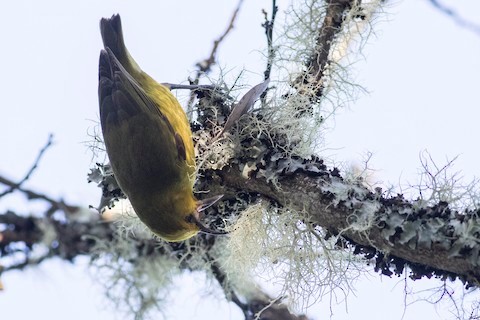
Akiapola’au, probing and peeling bark. (Hakalau Forest National Wildlife Refuge, Big Island, Hawaii; March 19, 2019.) © Jacob Drucker
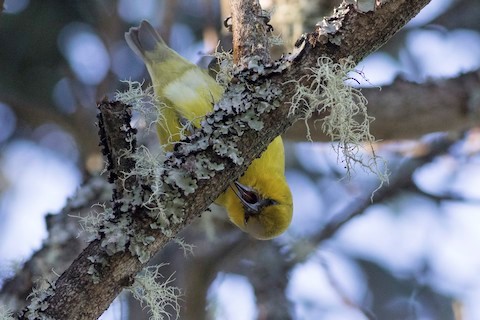
Akiapola’au, probing and peeling bark. (Hakalau Forest National Wildlife Refuge, Big Island, Hawaii; March 19, 2019.) © Jacob Drucker
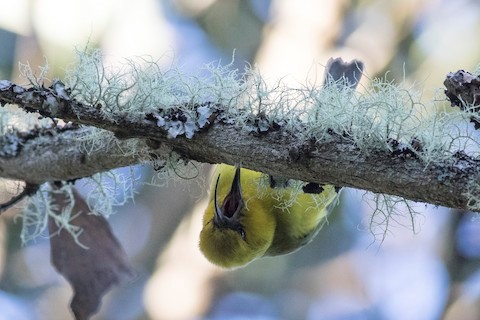
Akiapola’au, probing and peeling bark. (Hakalau Forest National Wildlife Refuge, Big Island, Hawaii; March 19, 2019.) © Jacob Drucker
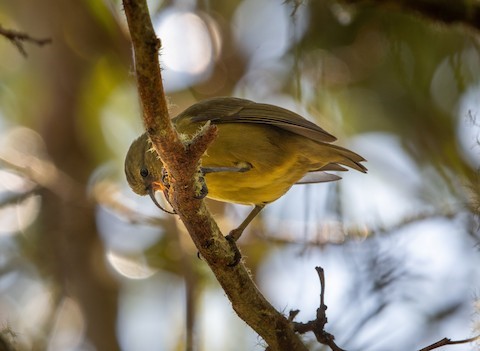
Akiapola’au, probing and peeling bark. (Hakalau Forest National Wildlife Refuge, Big Island, Hawaii; January 7, 2020.) © William Higgins
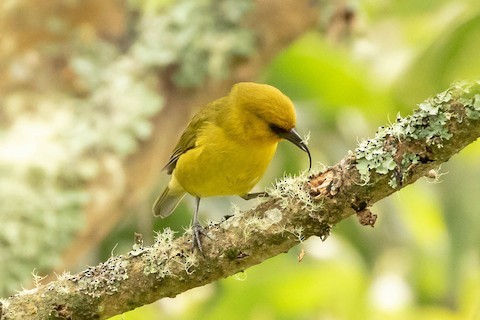
Akiapola’au, male. (Pua Akala Tract, Hakalau Forest National Wildlife Refuge, Big Island, Hawaii; June 4, 2018.) © Fred Hochstaedter
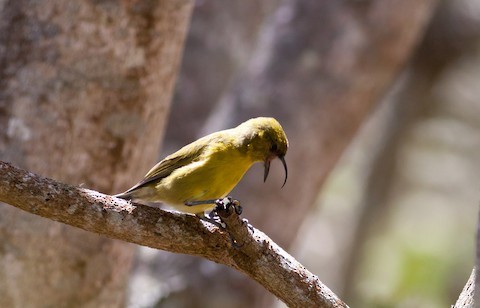
Akiapola’au, male. (Pu’u O’o Trail, Kipuka Ainahou, Big Island, Hawaii; July 17, 2013.) © Michael Todd
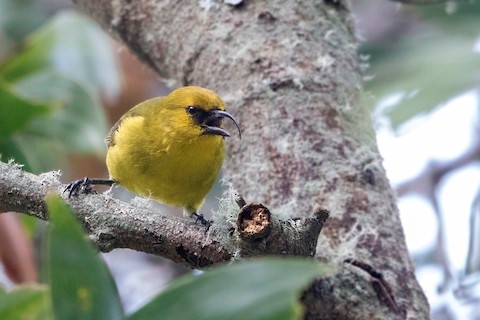
Yellow-fronted Canary, C. m. barbatus, showing essentially all-yellow plumage. (Naboisho Conservancy, Kenya; November 10, 2018.) © Allison Miller
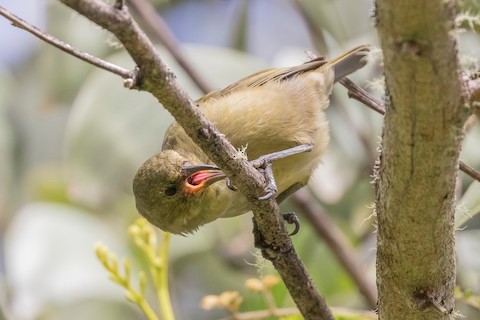
Akiapola’au, immature probing and peeling bark. (Pua Akala Tract, Hakalau Forest National Wildlife Refuge, Big Island, Hawaii; October 21, 2017.) © Sharif Uddin
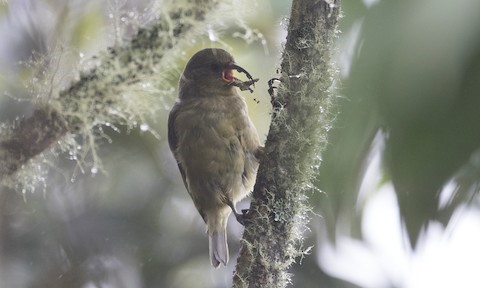
Akiapola’au, immature processing bark. (Pua Akala Tract, Hakalau Forest National Wildlife Refuge, Big Island, Hawaii; September 20, 2017.) © Brian Sullivan
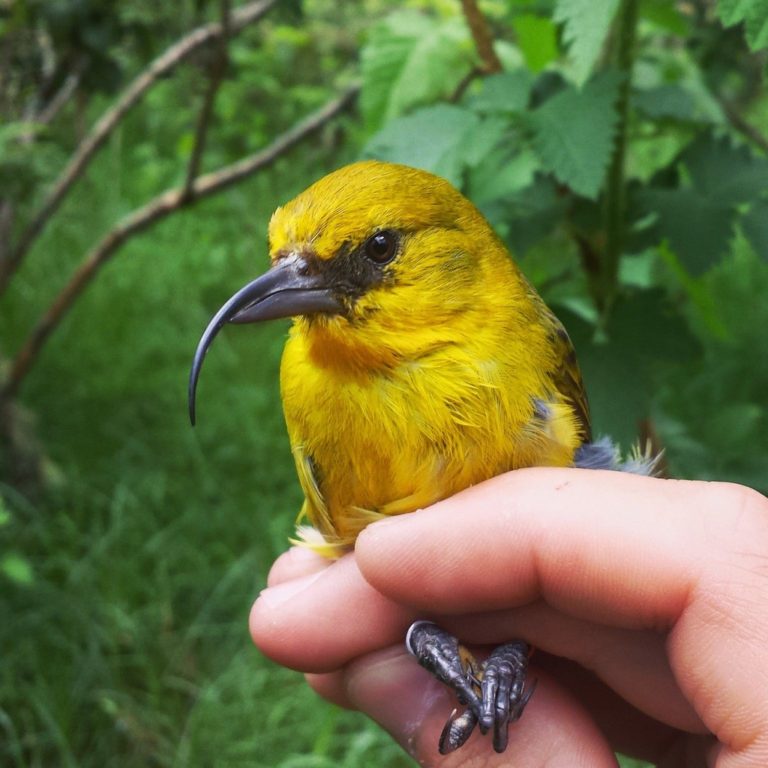
Akiapola’au, male, allowing a close study of its bizarre bill. (Hakalau Forest National Wildlife Refuge, Big Island, Hawaii; March 30, 2015.) © Alessandro Bartolo
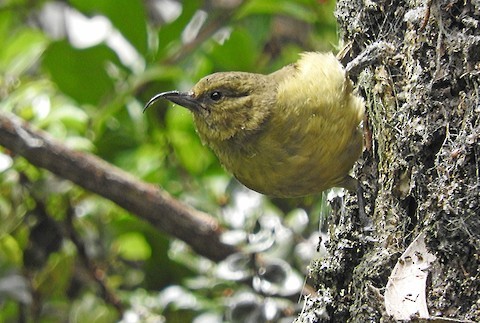
Akiapola’au, immature. (Hakalau Forest National Wildlife Refuge, Big Island, Hawaii; April 25, 2019.) © Tresa Moulton
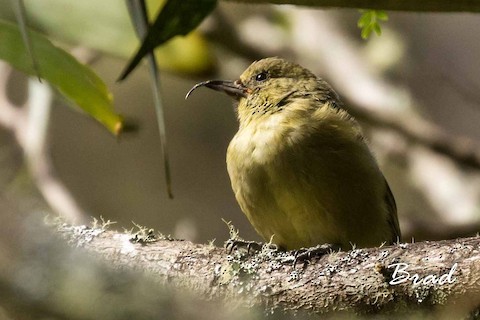
Akiapola’au, immature. (Pua Akala Tract, Hakalau Forest National Wildlife Refuge, Big Island, Hawaii; October 21, 2017.) © Brad Argue
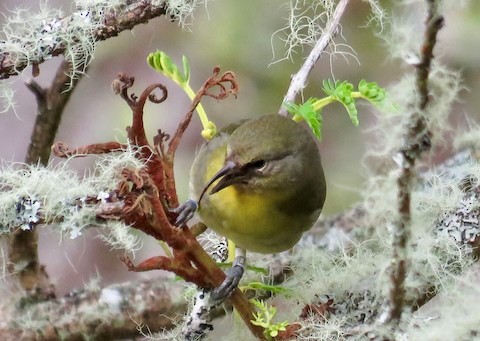
Akiapola’au, female. (Pua Akala Tract, Hakalau Forest National Wildlife Refuge, Big Island, Hawaii; August 9, 2017.) © Victor Stoll
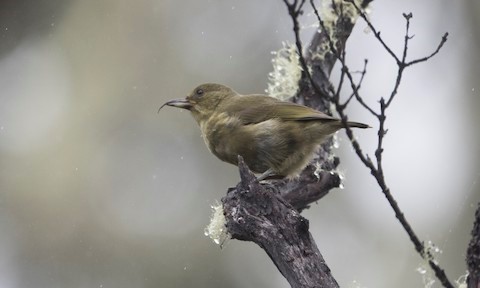
Akiapola’au, immature. (Pua Akala Tract, Hakalau Forest National Wildlife Refuge, Big Island, Hawaii; September 20, 2017.) © Brian Sullivan
Voice. Song varies, but typically consists of a series of crisp, clear notes, with the same distinct phrases repeated at regular intervals of a few seconds: Calls include 2- and 3-note whistles: Also a sharp chewp!:
Notes
Monotypic species.
IUCN Red List Status: Endangered.
References
BirdLife International. 2016. Hemignathus wilsoni. The IUCN Red List of Threatened Species 2016: e.T22720799A94683442. https://dx.doi.org/10.2305/IUCN.UK.2016-3.RLTS.T22720799A94683442.en. (Accessed May 13, 2020.)
eBird. 2020. eBird: An online database of bird distribution and abundance. Cornell Lab of Ornithology, Ithaca, N.Y. http://www.ebird.org. (Accessed May 13, 2020.)
Pratt, H.D. 2005. The Hawaiian Honeycreepers: Drepanidinae. Oxford University Press.
Pratt, H.D. 2020. Akiapolaau (Hemignathus wilsoni). In Handbook of the Birds of the World Alive (J. del Hoyo, A. Elliott, J. Sargatal, D.A. Christie, and E. de Juana, eds.). Lynx Edicions, Barcelona. https://www.hbw.com/node/61448. (Accessed May 9, 2020.)
Pyle, R.L., and P. Pyle. 2017. The Birds of the Hawaiian Islands: Occurrence, History, Distribution, and Status. Version 2 (January 1, 2017). http://hbs.bishopmuseum.org/birds/rlp-monograph/. B.P. Bishop Museum, Honolulu, Hawaii.
Xeno-Canto. 2020. Akiapolaau – Hemignathus wilsoni. https://www.xeno-canto.org/species/Hemignathus-wilsoni. (Accessed May 13, 2020.)
